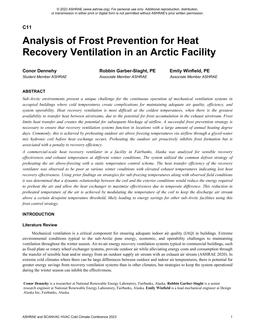Click here to purchase
Sub-Arctic environments present a unique challenge for the continuous operation of mechanical ventilation systems in occupied buildings where cold temperatures create complications for maintaining adequate air quality, efficiency, and system operability. Heat recovery ventilation is most difficult at the coldest temperatures, when there is the greatest availability to transfer heat between airstreams, due to the potential for frost accumulation in the exhaust airstream. Frost limits heat transfer and creates the potential for subsequent blockage of airflow. A successful frost prevention strategy is necessary to ensure that recovery ventilation systems function in locations with a large amount of annual heating degree days. Commonly, this is achieved by preheating outdoor air above freezing temperatures via airflow through a glycol-water mix hydronic coil before heat exchange occurs. Preheating the outdoor air proactively inhibits frost formation but is associated with a penalty to recovery efficiency. A commercial-scale heat recovery ventilator in a facility in Fairbanks, Alaska was analyzed for sensible recovery effectiveness and exhaust temperature at different winter conditions. The system utilized the common defrost strategy of preheating the air above-freezing with a static temperature control scheme. The heat transfer efficiency of the recovery ventilator was observed to be poor at various winter conditions with elevated exhaust temperatures indicating lost heat recovery effectiveness. Using prior findings on strategies for sub-freezing temperatures along with observed field conditions it was determined that a dynamic relationship between the coil and the exterior conditions would reduce the energy required to preheat the air and allow the heat exchanger to maximize effectiveness due to temperate difference. This reduction in preheated temperature of the air is achieved by modulating the temperature of the coil to keep the discharge air stream above a certain dewpoint temperature threshold, likely leading to energy savings for other sub-Arctic facilities using this frost control strategy.
Product Details
- Published:
- 2023
- Number of Pages:
- 9
- Units of Measure:
- Dual
- File Size:
- 1 file , 1.6 MB
- Product Code(s):
- D-CCC23-11
- Note:
- This product is unavailable in Russia, Belarus
